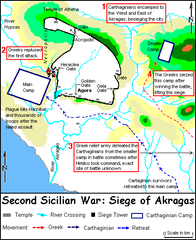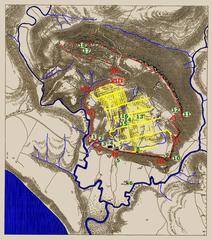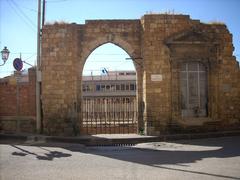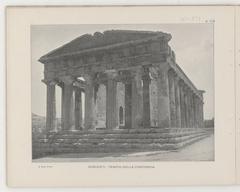
Comprehensive Guide to Visiting Agrigento, Free Municipal Consortium of Agrigento, Italy
Date: 14/08/2024
Captivating Introduction
Welcome to Agrigento, the captivating jewel of Sicily’s southern coast, where history and modern charm intertwine effortlessly. Imagine walking through a landscape where ancient Greek gods once roamed, with every stone telling a tale that spans millennia. Founded in 581 BCE by Greek colonists, Agrigento, originally known as Akragas, quickly flourished as a bustling hub of trade and cultural exchange (World History Encyclopedia). Picture a city that has seen it all—from the prehistoric beginnings of the Sicani and Sicels to its golden age under tyrants like Phalaris and Theron, and later transitions under Carthaginian, Roman, Arab, and Norman influences (Britannica) (Agrigento Ieri e Oggi).
Agrigento’s crowning glory is undoubtedly the Valley of the Temples, a UNESCO World Heritage site boasting some of the best-preserved Greek temples outside Greece itself, like the awe-inspiring Temple of Concordia and the Temple of Juno (UNESCO). But Agrigento’s allure isn’t just in its stones—it’s in its vibrant soul. Imagine exploring charming alleyways, noble palaces, and local markets brimming with Sicilian delicacies. Picture yourself at the Almond Blossom Festival or discovering the mesmerizing white cliffs of Scala dei Turchi (Visit Sicily).
Ready to uncover the secrets of Agrigento? With our guide, you’ll journey through time, savor local flavors, and immerse yourself in a rich cultural tapestry. Let’s dive in and explore Agrigento, a city where history whispers through the breeze and the past comes alive with every step.
Table of Contents
- History of Agrigento
- A Journey Through Time Begins
- Prehistoric Beginnings
- Greek Colonization
- The Golden Age
- The Valley of the Temples
- The Tyranny of Theron
- Transition to Democracy
- Carthaginian and Roman Conquests
- Roman Rule and Late Antiquity
- Medieval and Modern Periods
- Preservation and Cultural Significance
- Contemporary Agrigento
- Hidden Gems and Local Secrets
- Visitor Tips
- Seasonal Highlights
- Myth Busting and Surprises
- Interactive Elements
- FAQ
- Discover the Magic of Agrigento
- Visitor Tips for Agrigento
History of Agrigento
A Journey Through Time Begins
Imagine a place where history whispers through ancient ruins, and every stone tells a story. Welcome to Agrigento, the jewel of Sicily’s southern coast. Did you know Agrigento boasts one of the largest collections of ancient Greek temples outside Greece itself? Buckle up as we embark on a fascinating journey through this city’s rich and layered past.
Prehistoric Beginnings
Long before the Greeks set foot here, Agrigento’s fertile valleys, nestled between the Drago and Akragas rivers, were home to the Sicani and the Sicels. Picture this: ancient peoples crafting flint tools and setting up their communities in a land that promised abundance (Agrigento Ieri e Oggi).
Greek Colonization
Fast forward to around 581 BCE, when Greek colonists from Gela founded Akragas, now Agrigento. Think of it as an ancient boomtown, strategically placed for trade and cultural exchanges, its location near the river Akragas (now San Biagio) making it a bustling hub (World History Encyclopedia).
The Golden Age
Under the rule of the notorious tyrant Phalaris (570–554 BCE), Agrigento grew exponentially. Imagine living in a city so prosperous that it boasted a population of 300,000! Despite Phalaris’ cruel reputation, the city thrived, its wealth visible in the splendid temples that still stand today (Britannica).
The Valley of the Temples
Step into the Valley of the Temples, an open-air museum of ancient grandeur. Here, you’ll find some of the best-preserved Greek temples, like the Temple of Concordia and the Temple of Juno. These awe-inspiring structures are a must-see for any history enthusiast (UNESCO).
The Tyranny of Theron
Agrigento’s golden age reached its zenith under Theron (488–472 BCE), who led the city to victory against the Carthaginians at the Battle of Himera in 480 BCE. Picture Agrigento at its peak, with grand public works and temples that showcased its wealth and power (World History Encyclopedia).
Transition to Democracy
In 470 BCE, a new dawn broke as Agrigento transitioned to a democracy. The city became a beacon of arts and philosophy, the birthplace of the philosopher-politician Empedocles, who contributed significantly to pre-Socratic philosophy and science (Britannica).
Carthaginian and Roman Conquests
Agrigento’s allure made it a target for powerful neighbors. It was ravaged by the Carthaginians in 406 BCE, and despite a brief resurgence under the Greek general Timoleon in 338 BCE, it faced further sacking by the Romans in 262 BCE and the Carthaginians again in 255 BCE before finally falling to Rome in 210 BCE (Agrigento Ieri e Oggi).
Roman Rule and Late Antiquity
Under Roman rule, Agrigento, now Agrigentum, saw modest prosperity due to its agricultural wealth and sulfur mines. Imagine the city’s inhabitants retreating to the medieval hilltop town of Girgenti for safety, laying the foundations for modern Agrigento (Britannica).
Medieval and Modern Periods
Agrigento’s story continued through the medieval period with notable events like the Saracen occupation in 828 CE and its capture by Norman Count Roger I in 1087 CE. The Normans left a lasting impact, integrating the city into the broader medieval European context (Agrigento Ieri e Oggi).
Preservation and Cultural Significance
Fast forward to the modern era, where efforts to preserve Agrigento’s ancient ruins took center stage. Mussolini’s policies in the 20th century aimed to revive Italy’s ancient heritage, spotlighting the Valley of the Temples. These efforts helped secure Agrigento’s status as a UNESCO World Heritage Site in 1997 (Agrigento Ieri e Oggi).
Contemporary Agrigento
Today, Agrigento stands as a living testament to its rich history. The Valley of the Temples remains a central attraction, drawing visitors worldwide. Imagine walking through time, exploring ancient relics alongside a vibrant cultural scene (Peek).
Hidden Gems and Local Secrets
Beyond the famed temples, venture into the heart of Agrigento’s historic center. Discover noble palaces, charming alleyways, and the local nightlife that offers a taste of the city’s vibrant soul. Don’t miss the local markets, where you can savor Sicilian delicacies and perhaps even stumble upon a quirky local custom.
Visitor Tips
The best time to explore the Valley of the Temples is during the cooler months of March, April, October, or November. The site is quite exposed, so wear sunscreen and bring water. To avoid the crowds, visit early in the morning or at sunset. And for an immersive experience, download the Audiala app for expertly crafted audio guides (Travelling King).
Seasonal Highlights
Agrigento transforms with the seasons. Spring brings vibrant blooms and mild weather, perfect for outdoor exploration. Summer is bustling with festivals, while autumn offers a quieter charm. Winter, though cooler, provides a unique, serene beauty to the ancient ruins.
Myth Busting and Surprises
Did you know that Agrigento was once thought to be the site of the mythical Garden of the Hesperides? Or that its ancient population was among the largest in the Mediterranean? These are just a few surprising facts that add to the allure of this fascinating city.
Interactive Elements
Ready for a mini-quest? Find the hidden lion carved into the Temple of Concordia. Legend has it that spotting it brings good luck! Or, try the local challenge of mastering a few Sicilian phrases. Start with “Ciao, comu stai?” (Hi, how are you?) and see the locals’ faces light up.
FAQ
Q: How do I get to the Valley of the Temples? A: The easiest way is by bus or car. The site is well-signposted and has ample parking.
Q: Are there guided tours available? A: Yes, guided tours are available, but for a flexible, in-depth experience, download the Audiala app.
Q: What should I wear? A: Comfortable walking shoes, sunscreen, and a hat are recommended due to the site’s exposure.
Q: Is the site wheelchair accessible? A: Parts of the Valley of the Temples are accessible, but some areas may be challenging due to uneven terrain.
Discover the Magic of Agrigento
A Journey Through Time
Welcome to Agrigento, a city where ancient history meets modern charm on the southern coast of Sicily. Imagine walking through a place where Greek gods once roamed, and you’ll start to get a feel for Agrigento. Founded by Greek colonists in 581 BCE, this city, originally known as Akragas, quickly flourished as a bustling hub in ancient Magna Graecia. Picture a city with a population rivaling modern metropolises—between 200,000 and 800,000 souls—alive with trade and cultural exchange (Italy Magazine).
Through the ages, Agrigento has seen it all. Conquered by Carthaginians, revived under Roman rule, and later influenced by Arab and Norman cultures, this city has a rich tapestry of stories to tell. It was known as Girgenti for centuries until it was renamed Agrigento in 1927, a nod to its Latin heritage (Italy Magazine).
Architectural Marvels
Step into the Valley of the Temples, a UNESCO World Heritage site since 1997, and you’ll find yourself amidst some of the finest examples of Doric architecture. Imagine standing before the Temple of Concordia, one of the best-preserved ancient Greek temples in the world—what stories would these stones tell if they could speak? The Valley is a treasure trove, with seven majestic temples that have withstood the test of time (Italy Magazine).
A Cultural Tapestry
Agrigento’s allure isn’t just in its stones but in its soul. Picture yourself on the Strada degli Scrittori, a route that takes you through a literary journey in the Valley of the Temples. Visit during the Sagra del Mandorlo in Fiore, the Almond Blossom Festival, and you’ll be enchanted by the vibrant mix of cultures celebrating together. The highlight? The mesmerizing lighting of the tripod of friendship in front of the Temple of Concordia (Visit Sicily).
Don’t miss the Museo Archeologico Regionale di Agrigento, a treasure trove of artifacts, including the towering telamon and the stunning Ephebus of Agrigento. Adjacent to the museum, the Chiesa di San Nicola houses the Phaedra sarcophagus, a masterpiece of Roman sculpture (Visit Sicily).
Nature’s Canvas
Agrigento isn’t just about history; it’s about nature’s artistry too. Imagine the Scala dei Turchi, a dazzlingly white cliff sculpted by wind and sea, forming natural terraces that beckon you to climb and explore. It’s a sight that will leave you breathless (Visit Sicily).
The Giardino della Kolymbethra, managed by the FAI, is a hidden gem within the Valley of the Temples. This lush garden, brimming with citrus trees, pistachios, and ancient waterworks, offers a serene escape and a perfect backdrop for events and concerts (Visit Sicily).
Insider Tips for the Savvy Traveler
- Best Time to Visit: Spring and summer are perfect, with pleasant weather and blooming almond trees. The Almond Blossom Festival between February and March is an extra treat.
- Must-See Spots: The Valley of the Temples and Giardino della Kolymbethra are top picks. Dive deep into history at the Museo Archeologico Regionale di Agrigento.
- Local Flavors: Savor the unique gelato pecorino, made from sheep’s milk ricotta, and indulge in almond and pistachio pastries crafted by local nuns.
- Beach Bliss: Explore the stunning beaches from Marina di Licata to Punta Bianca. San Leone is your go-to for a mix of lively and secluded shores (Visit Sicily).
A Call to Adventure
Agrigento is more than a destination; it’s an experience. Whether you’re a history buff, a nature lover, or a culinary explorer, Agrigento has something to offer. So pack your bags, lace up your walking shoes, and get ready to uncover the hidden gems and timeless tales of this Sicilian jewel.
Visitor Tips for Agrigento
Introduction
Welcome to Agrigento, Sicily’s ancient heartland where history whispers through every breeze and the past comes alive with every step. Get ready for an adventure packed with awe-inspiring ruins, mouth-watering cuisine, and a dash of Sicilian charm. Let’s dive in!
Best Time to Visit
Agrigento’s mild climate makes it a year-round destination, but the true magic happens in spring (April-May) and autumn (September-October). Picture this: blooming flowers, temperate weather, and fewer tourists—it’s like having the Valley of the Temples all to yourself! (Salt Sicily).
Getting There
Agrigento is closer than you think! Here’s how:
- By Air: Fly into Palermo, Catania, or Trapani airports. From there, it’s a scenic two-hour drive to Agrigento. Daily flights from major European cities make this a breeze (Ditisitalie).
- By Car: Renting a car offers freedom to explore. You can even take a ferry from Genoa to Palermo—a 20-hour journey that feels like a Mediterranean cruise (Ditisitalie).
- By Bus: Buses are frequent and reliable, connecting Agrigento with other Sicilian gems (Ditisitalie).
Accommodation
Sleep tight, whatever your budget:
- Luxury Hotels: Bask in opulence near the Valley of the Temples.
- Mid-Range Hotels: Stay central and close to local eateries.
- Budget Hotels: Enjoy seaside views in the Leone neighborhood without breaking the bank (Planetware).
What to Wear
Pack smart: comfy shoes for uneven ancient paths, water, and sunscreen for that Sicilian sun. You’ll thank us later! (Salt Sicily).
Key Attractions
Valley of the Temples
Imagine stepping back in time at the Valley of the Temples, a UNESCO World Heritage Site with eight stunning temples from 510-430 BCE. Don’t miss the Temple of Concordia and the Temple of Hera (Voyage Tips).
- Entrance Fee: €12, or €15.50 with the Archaeological Museum. Grab a site map for just €1 (Voyage Tips).
- Parking: Paid lots at each end, max €5/day (Voyage Tips).
Scala dei Turchi
Discover the Scala dei Turchi, a naturalmarvel with its white marl cliffs and mesmerizing Mediterranean views. It’s an Instagrammer’s paradise! (Salt Sicily).
Practical Tips for Visiting the Valley of the Temples
- Timing: Beat the heat and crowds by visiting early or late. Open daily 8:30 AM - 8:00 PM, longer in summer (Ditisitalie).
- Guided Tours: Enrich your visit with a guided tour. Evening tours offer a magical, illuminated experience (The Geographical Cure).
Dining Options
Agrigento’s culinary scene is as rich as its history:
- L’Operà: Feast on pizza and pasta with sea views on Via Atenea. Don’t miss the complimentary limoncello (Ditisitalie).
- Boccondivino and Dacànto: Dine on a staircase for a unique experience (Ditisitalie).
Cultural Events
Festa di San Calogero
Join the Festa di San Calogero in early July, celebrating the monk Calogero with processions, concerts, exhibitions, and a grand fireworks display (Ditisitalie).
Additional Tips
- Local Cuisine: Savor Agrigento’s Mediterranean flavors with Greek influences. Try local specialties (Salt Sicily).
- Farm Cultural Park: Visit the Farm Cultural Park in Favara for modern art, street murals, and sculptures (Planetware).
- Hidden Gems: Explore the less-touristy alleys and markets for an authentic Sicilian vibe.
Interactive Elements
Mini-Quest: Find the best cannoli in Agrigento! Post your favorite on social media with #AgrigentoCannoliChallenge.
Local Lingo
Phrase of the Day: “Grazie mille” (Thank you very much). Use it to show your gratitude and make a connection with locals.
Call to Action
As you conclude your journey through Agrigento, imagine the stories that each ancient ruin and vibrant street have shared with you. From the prehistoric roots of the Sicani and Sicels to the grandeur of Greek colonization and the marvels of the Valley of the Temples, Agrigento stands as a living testament to a rich and layered past (Agrigento Ieri e Oggi). This historical city has weathered conquests, transitioned through various rulers, and evolved into a contemporary marvel that still retains its ancient charm.
But Agrigento is not just about history; it’s a sensory experience. The flavors of Sicilian cuisine, the vibrant colors of local festivals, the serene beauty of Scala dei Turchi, and the lush greenery of Giardino della Kolymbethra all paint a picture of a city that offers something for everyone (Visit Sicily). Whether you’re a history buff, a nature lover, or a culinary explorer, Agrigento invites you to dive deep into its wonders.
So, why wait? Download Audiala, your personal tour guide app, and let it lead you through Agrigento’s hidden gems and timeless tales. With expertly crafted audio guides, you’ll experience the city’s rich history and vibrant culture at your own pace. Embark on an unforgettable journey and let Agrigento reveal its secrets and stories just for you.
References
- Agrigento a Historical Journey Through Magna Graecia and Beyond. (n.d.). Agrigento Ieri e Oggi. Retrieved from Agrigento Ieri e Oggi
- Discovering Agrigento. (n.d.). World History Encyclopedia. Retrieved from World History Encyclopedia
- Encyclopedia Britannica. (n.d.). Agrigento. Retrieved from Britannica
- UNESCO World Heritage Centre. (n.d.). Archaeological Area of Agrigento. Retrieved from UNESCO
- A Journey Through Agrigento. (n.d.). Visit Sicily. Retrieved from Visit Sicily





